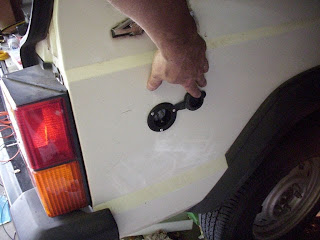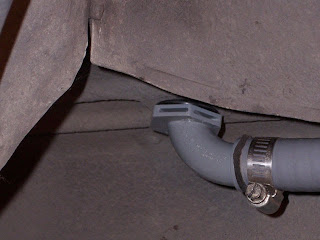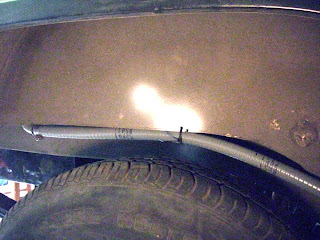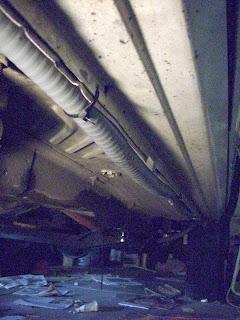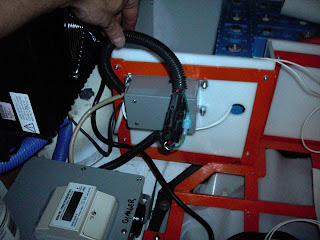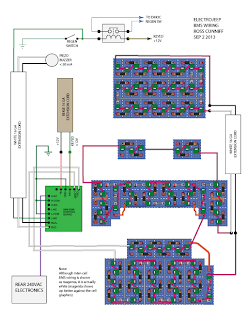Today, I did some wiring toward getting the BMS in place.
First, I added some wires in the passenger's side of the rear compartment. The green extension cord plug will eventually be the 120VAC battery warming power supply. The green cord going into the cable gland and the silver thermocouple wire are also for the battery warming system (for the front box). The white extension cord is for the BMS loop:
Here is the inlet for the battery warming plug. I'm not going to do much more on this part for now (it's still pretty warm :-) but I wanted to get the hole-drilling and cable pulling out of the way:
The conduit proceeds forward along the wheel well...
...under the passenger-side rocker...
...and ends up in the engine compartment. The silver thermocouple will go into the battery box; the white as mentioned will carry the BMS loop to these cells.
Here is everything all closed up and connected. I tried plugging an EVSE in to see whether the kWh meter lit (and the charger light lit) but, no joy in Mudville tonight - the EVSE flashed a "line cord fault" indication. I suspect I have the pilot and control lines reversed. But for now, this *looks* pretty:
Here is the wiring diagram for the BMS. I have not yet done the inter-cell connections (shown here in magenta, but I'll use white wires). The PDF of this diagram can be found at this link.
So, this is probably as far as I get for the next few weeks - but I look forward to finishing the BMS wiring and trying a quick top-off charge cycle...
EDIT Sep 3 2013: Swapping the PRX and PIL lines on the J1772 AVC1 unit fixed the problem! I verified that all the other circuity is installed properly and working - connecting the cell loop (with no cells) causes the charge relay to engage, the 12V power supply is working, and everything seems happy. The circuit diagram for that circuitry has been updated, as has been the previous post.
First, I added some wires in the passenger's side of the rear compartment. The green extension cord plug will eventually be the 120VAC battery warming power supply. The green cord going into the cable gland and the silver thermocouple wire are also for the battery warming system (for the front box). The white extension cord is for the BMS loop:
Here is the inlet for the battery warming plug. I'm not going to do much more on this part for now (it's still pretty warm :-) but I wanted to get the hole-drilling and cable pulling out of the way:
The green, white, and silver cables go through the floor of the rear compartment to this LiquiTight conduit gland:
The conduit proceeds forward along the wheel well...
...under the passenger-side rocker...
...and ends up in the engine compartment. The silver thermocouple will go into the battery box; the white as mentioned will carry the BMS loop to these cells.
With the cabling out of the way, I wired up the BMS controller. I went back and forth on whether to put this under the dash or in the rear - in either case, we needed some signals routed between front and back. The deciding factor was that this placement is much more convenient to work on:
Here is everything all closed up and connected. I tried plugging an EVSE in to see whether the kWh meter lit (and the charger light lit) but, no joy in Mudville tonight - the EVSE flashed a "line cord fault" indication. I suspect I have the pilot and control lines reversed. But for now, this *looks* pretty:
Here is the wiring diagram for the BMS. I have not yet done the inter-cell connections (shown here in magenta, but I'll use white wires). The PDF of this diagram can be found at this link.
So, this is probably as far as I get for the next few weeks - but I look forward to finishing the BMS wiring and trying a quick top-off charge cycle...
EDIT Sep 3 2013: Swapping the PRX and PIL lines on the J1772 AVC1 unit fixed the problem! I verified that all the other circuity is installed properly and working - connecting the cell loop (with no cells) causes the charge relay to engage, the 12V power supply is working, and everything seems happy. The circuit diagram for that circuitry has been updated, as has been the previous post.

